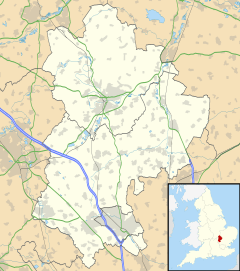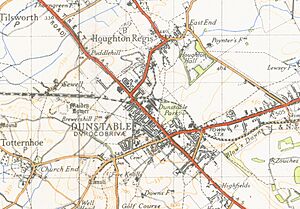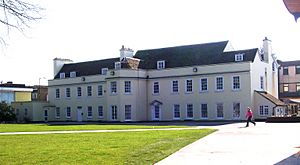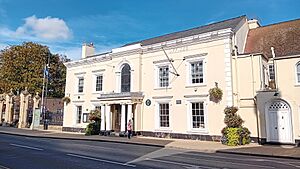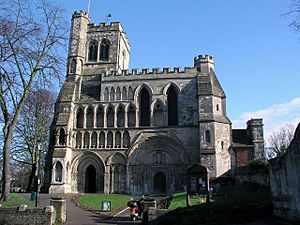Dunstable facts for kids
Quick facts for kids Dunstable |
|
|---|---|
 Clock Tower and Market Cross |
|
| Population | 40,699 |
| OS grid reference | TL0121 |
| Civil parish |
|
| Unitary authority | |
| Ceremonial county | |
| Region | |
| Country | England |
| Sovereign state | United Kingdom |
| Post town | DUNSTABLE |
| Postcode district | LU5, LU6 |
| Dialling code | 01582 |
| Police | Bedfordshire |
| Fire | Bedfordshire and Luton |
| Ambulance | East of England |
| EU Parliament | East of England |
| UK Parliament |
|
Dunstable is a busy market town and civil parish in Bedfordshire, England. It's located east of the Chiltern Hills, about 30 miles (48 km) north of London. You'll notice some steep chalk hills when you approach Dunstable from the north. Dunstable is the fourth largest town in Bedfordshire. It forms the western part of the Luton/Dunstable urban area along with Houghton Regis.
<mapframe width=282 height=250 zoom=13 latitude=51.88603 longitude=-0.52102 />
Contents
What's in a Name?
In Roman times, Dunstable was called Durocobrivis. This name was likely a "fossilised locative," meaning it was used all the time to describe the place.
There are a few fun stories about how Dunstable got its modern name:
- One legend says a thief named Dun caused trouble. The King challenged him by stapling his ring to a post. Dun stole it, and was caught. The new town was then named after him.
- Another idea is that it comes from an old Anglo-Saxon phrase meaning "the boundary post of Duna."
- It might also come from Dunum (a hill) and Staple (a marketplace).
Dunstable's Past
Ancient Times
People lived in this area a very long time ago, even before recorded history! We know this from ancient tools made of flint and bones of wild animals found here. At Maidenbower, near Houghton Regis, there's an Iron Age hill fort. You can still see parts of its old walls. Dunstable is also on the Icknield Way, which is thought to be one of Britain's oldest roads.
Roman Settlement
When the Romans arrived around AD 40-50, there was already a settlement here. The Romans paved the road we now call Watling Street and its crossroad, the Icknield Way. They built a special station for travelers and probably named the place Durocobrivae, which later became Durocobrivis. Around AD 571, the area was settled by the Saxons.
Medieval History
Before the 11th century, this area was mostly wild woodlands. In 1109, King Henry I decided to make it safer for travelers. He ordered the land to be cleared and encouraged people to settle there. He even built a royal home in 1123, which is now the Royal Palace Lodge Hotel. The King used it for hunting.
The Dunstable Priory was founded in 1131 by King Henry I. This priory became famous later when it was used for the divorce between Henry VIII and Catherine of Aragon. This event was a big part of why the Church of England was created, separate from the Catholic Church.
In 1290, Dunstable was one of twelve places to have an Eleanor cross. These crosses honored Eleanor of Castile, wife of King Edward I, after she died. Her coffin rested near the crossroads for people to mourn.
The 17th Century
During the English Civil War, Bedfordshire mostly supported the Roundheads. Dunstable was sometimes used by soldiers. In 1644, King Charles I's soldiers took things from the town. The Eleanor cross was also destroyed by soldiers.
Dunstable became a wealthy town because it was a good place for travelers to stop overnight. It was about a day or two's ride by horse from London. Many old public houses (pubs) in town still have special gates for coaches. Two examples are the Sugar Loaf and the Saracen's Head.
The 19th Century
Dunstable got its first railway in 1848, connecting it to Leighton Buzzard. Another line opened in 1858, linking Dunstable to Hatfield through Luton. Passenger trains stopped running to Dunstable in 1965, but the line was still used for goods for many years.
Dunstable was an important market town, but its importance lessened as the nearby town of Luton grew much larger.
Modern Times
In the early 1900s, Dunstable became known for printing and making motor vehicles. Companies like Waterlow's (printing) and Vauxhall Motors (vehicles) were here. The new Bedford Dunstable plant started making trucks and buses in 1942 to help the British Army during the Second World War. This factory closed in 1992.
The town centre used to be a very successful shopping area. In 1966, the Quadrant Shopping Centre opened. Many big shops like Sainsbury's and Tesco were there, along with smaller local stores. However, like many towns, Dunstable saw a decline in town centre shopping when larger retail parks opened outside of town.
Today, you can still find major shops like Asda, Wilkinson, and Aldi in the town centre. Costa Coffee, a big coffee chain, has its main office here.
How Dunstable is Governed
Dunstable has two levels of local government: the Dunstable Town Council and the Central Bedfordshire Council. The Town Council has its offices at Grove House.
The town is served by the Bedfordshire Police force. The person in charge of policing, called the Police and Crime Commissioner, is Festus Akinbusoye. He is the first black Briton to hold this position.
Dunstable used to be an old borough, but it lost that status. In 1864, it became a municipal borough again. This borough was later replaced by other councils. In 1985, the new civil parish of Dunstable was created, and its council became the Dunstable Town Council.
Dunstable's Location and Layout
The oldest part of Dunstable is where the Icknield Way and Watling Street roads cross. These roads divide the town into four main areas, which have grown over time.
- The northwest area started developing in the 1800s. After the Second World War, more houses were built.
- The southwest area mostly grew after the Second World War. It has estates with streets named after places in the Lake District.
- The southeast area also saw development in the late 1800s and after the Second World War.
- The northeast area is mostly for businesses and public buildings. Old factory sites here have been turned into houses.
Further east, near Luton, there are more areas that developed after the Second World War. This includes the Woodside Estate, where most of the factories and warehouses in Dunstable are located.
Getting Around Dunstable
Roads
The A5 used to be the main road through Dunstable. Now, a new bypass (the A5-M1 Link) helps traffic go around the town. The old A5 through town is now called the A5183 and has a weight limit for heavy vehicles. The M1 motorway is also close by, east of the town in Luton.
Buses
Dunstable has bus services run by Arriva and Centrebus. These buses connect Dunstable to nearby towns like Luton, Leighton Buzzard, and St Albans. Centrebus also runs local services within Dunstable.
Luton Dunstable Busway
A special bus route called the Luton Dunstable Busway opened in 2013. It connects Houghton Regis, Dunstable, Luton, and Luton Airport. Much of this busway uses the path of an old railway line. Buses can travel very fast on this special guided section, up to 50 mph (80 km/h), with few stops.
Trains
Dunstable used to have train lines to Leighton Buzzard and Luton. While there have been ideas to bring passenger trains back, the Busway now uses the old railway route. Dunstable is one of the largest towns in the south of England without its own train station. However, it's close to train stations in Luton, like Leagrave and Luton, which have fast train links to London.
New Road Projects
A5-M1 Link (Dunstable Northern Bypass)
The A5-M1 Link, which opened in 2017, is a new dual carriageway. It runs east from the A5 north of Dunstable to a new junction (J11a) on the M1. This road helps reduce traffic in Dunstable and Houghton Regis and makes journeys faster.
Woodside Link
The Woodside Link is a 1.8-mile (2.9 km) road that connects industrial areas of Dunstable and Houghton Regis to the new M1 junction 11a. This road helps take traffic out of the town centre and improves air quality. It also helps with access to new housing developments.
Fun Things to Do in Dunstable
Culture and Entertainment
The Grove Theatre, which opened in 2007, is the main arts centre in town. It has 780 seats. There's also The Little Theatre, home to the Dunstable Rep Theatre Group, which puts on plays. Many local amateur drama groups also perform shows throughout the year.
The Grove Park complex has a Wetherspoons pub called The Gary Cooper (named after the famous actor who went to school here). It also has Central Bedfordshire College and BBC Three Counties Radio.
Sports and Activities
Central Bedfordshire Council looks after several parks and open spaces. The Dunstable Leisure Centre reopened in 2019 after a big renovation. It has swimming pools, a gym, and spaces for community services. It's next to the Grove Theatre and a modern 32-lane ten-pin bowling centre.
Dunstable has two football clubs, Dunstable Town F.C. and AFC Dunstable, both playing at Creasey Park Stadium. Dunstable Town once famously had football legend George Best play for them!
The Dunstablians rugby club plays in nearby Houghton Regis.
Lancot Meadow is a small nature reserve managed by the local Wildlife Trust. Blow's Down, a special scientific site, is next to the Luton-Dunstable busway.
Dunstable Downs Golf Club, designed by James Braid, is located on top of the Downs.
Famous Places to See
In the town centre, you can visit the Grove Theatre, Priory House Heritage Centre, and the Priory Church. This is where Henry VIII's divorce from Catherine of Aragon was made official. The Quadrant Shopping Centre is in the heart of town. There's also a modern statue at Eleanor's Cross Shopping Precinct, remembering the original Eleanor Cross.
Just outside town are the Dunstable Downs. These chalk hills are a popular spot for kite flying, paragliding, and hang gliding. The London Gliding Club is also nearby. You can also visit the open-range Whipsnade Zoo, the unique Whipsnade Tree Cathedral, and the old Totternhoe Knolls castle.
The Icknield Way Path goes through Dunstable. It's a 110-mile (177 km) journey for walkers, horse riders, and cyclists.
Schools in Dunstable
Here are some of the Secondary schools in Dunstable:
- All Saints Academy, Dunstable
- Queensbury Academy
- Manshead CE Academy
The Priory Academy is a combined Middle and Upper School for children aged 9 to 16. Most secondary schools in Dunstable also have sixth forms for older students.
The Chiltern School and Weatherfield Academy are special schools in Dunstable that teach students from the wider Central Bedfordshire area.
Central Bedfordshire College is a college for further education, serving students from Dunstable and the surrounding countryside.
Famous People from Dunstable
Many interesting people have connections to Dunstable:
- John Dunstaple (around 1390 -1453), a famous 15th-century composer, is thought to have been born here.
- Gary Cooper (1901-1961), a well-known actor, went to Dunstable Grammar School.
- Khawaja Nazimuddin (1894-1964), who became a Prime Minister of Pakistan, also attended Dunstable Grammar School.
- Kevin McCloud (born 1959), a designer and TV presenter, went to school in Dunstable.
- Faye Tozer (born 1975), a member of the pop group Steps, is from Dunstable.
- Don Gilét (born 1967), an actor known for EastEnders, was born here.
Twin Towns
Dunstable is twinned with:
- Bourgoin-Jallieu, France
- Porz (Cologne), Germany
It's also unofficially twinned with Dunstable, Massachusetts in the United States.
Nearby Places to Visit
 |
Milton Keynes | Bedford | Houghton Regis |  |
| Leighton Buzzard | Luton | |||
| Tring | Hemel Hempstead | Harpenden |
See also
 In Spanish: Dunstable para niños
In Spanish: Dunstable para niños


